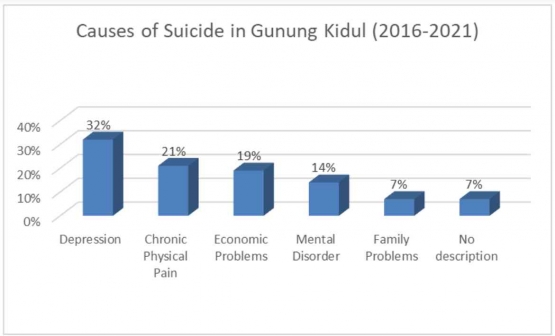Figure 1.9 below shows that the major cause of suicide in Gunungkidul is depression followed by chronic illness and economic problems. Studies reveal that depression is not caused by merely having too much or too little of a certain brain chemical. Rather, there are other potential reasons of depression, such as stressful life experiences, genetic susceptibility, and improper mood regulation by the brain. Depression is believed to be caused by the interaction of many of those triggers (Harvard Medical School, 2022).
Psychiatrist Ida Rochmawati of the regency-owned hospital RSUD Wonosari, stated that mood fluctuations and an abrupt loss of energy and interest could be signs of depression, which is the primary cause of suicides (Susanto, 2015). In comparison to frustration and stress, which are merely feelings, depression is a chronic medical illness in which the sufferer experiences constant feelings of excitement and depression. They experience sadness, nervous, empty, hopeless, powerless, inconsequential, and other similar feelings for a fair amount of time (Andari et al., 2022).
A further explanation for the terrifying urge to commit suicide, in accordance to Erickson's theory of psychosocial development, is alienation. Andari et al. (2022) went over how conflicting emotions rob people of their sense of self-worth, authenticity, and connection; additionally, they may exacerbate loneliness. They also look at how suicidality and loneliness emerge in early life, adolescence, young adulthood, middle age, and older age (Andari et al., 2022).
Loneliness is also one of the causes of an individual committing suicide in Gunungkidul, especially for elder population. As stated by Ida Rochmawati on The Jakarta Post, many elderly in Gunungkidul have seen their children migrate to big cities for a better job and more promising future. This is due to the regency being dominated by hilly karst and infertile land. The limitation in economic opportunities makes the younger generation face difficulties in surviving economic hardships (Susanto, 2015).
Based on a research conducted by Zhu et al. (2018), it was discovered that among elder community living in rural areas, psychological distress had the largest overall and direct impact on suicidal thoughts, followed by chronic illness and disability. It was found that while disability only had an indirect effect on suicide ideation through psychological distress, chronic illness had a partial direct and partial indirect effect (Zhu et al., 2018). Moreover, Gunungkidul does not have a mental hospital and only has a few psychiatrists. Despite the fact that depression and other mental disorders require regular treatment and medication that must be taken daily. Unfortunately, some elderly who suffer from the said disorder often do not have ID cards, which means they cannot get health insurance. The region itself is not yet secured in terms of healthcare. From figure 1.5, we find that the healthcare facility in Gunungkidul is the least developed among other regions/cities in the province of Daerah Istimewa Yogyakarta.
Chronic illness and limited healthcare access can be the trigger for some late-aged people to commit suicide. Elders who committed suicide often did so as a result of incurable chronic illness and the loneliness after their children moved out for urbanization (Zhu et al., 2018). They would feel abandoned and in lack of emotional support and attention in fighting the illness, causing them to feel overwhelming psychological distress (Andari et al., 2022). The absence of mental hospitals and psychiatrists as well as the lack of mental health awareness adds fuel to the fire. The complexity of those factors drives these elders to kill themselves, resulting in them dominating the already high suicide rate of Gunungkidul's.
Responding to this issue, Gunungkidul's local government formed Satuan Tugas Berani Hidup in 2016. Nevertheless, their performance is questionable. It has almost been a decade since the team was formed, yet the suicide rate in Gunungkidul is still high. There has not been any favorable outcome from the formation of the team. It can be concluded that Satgas Berani Hidup is not as progressive in terms of taking preventive measures, identifying individuals experiencing symptoms of depression or mental disorders, and providing treatment for the effects of suicide. Since it stopped frequently, especially during Covid-19 pandemic, the team's movements were even somewhat difficult to track (Chairina, 2023).
Inti Mata Jiwa (IMAJI), a non-governmental organization which mission is to improve the community's mental wellbeing in Gunungkidul, is a solid form of community's involvement and contribution in addressing this issue. Utilizing science and technology, IMAJI consistently provide the community with support groups, counselling, and research-publications on mental health, as well as promoting mental health awareness as the act of suicide prevention in Gunungkidul (IMAJI, n.d.).
Conclusion
Essentially, the rise in suicides in Gunungkidul, despite its picturesque landscapes, stems from a combination of societal and economic challenges intertwined with mental health concerns. Economic factors like unemployment, lack of earnings, and debt cycle foster a sense of hopelessness, exacerbated by issues like depression and social isolation. The elderly, in particular, face hardships due to illness and lack of support. Limited mental health services and awareness further compound the problem. Addressing this multifaceted phenomenon necessitates comprehensive interventions that address socio-economic disparities and mental health stigma, while concurrently ensuring accessible healthcare provisions and fostering community support networks. It is only through concerted efforts that the tragic cycle of suicide can be effectively countered, thereby enabling Gunungkidul to flourish as a region renowned for its natural allure, untainted by the specter of human tragedy.
References


















